GMC SAVANA 2021 Owner's Manual
Manufacturer: GMC, Model Year: 2021, Model line: SAVANA, Model: GMC SAVANA 2021Pages: 292, PDF Size: 6.38 MB
Page 181 of 292
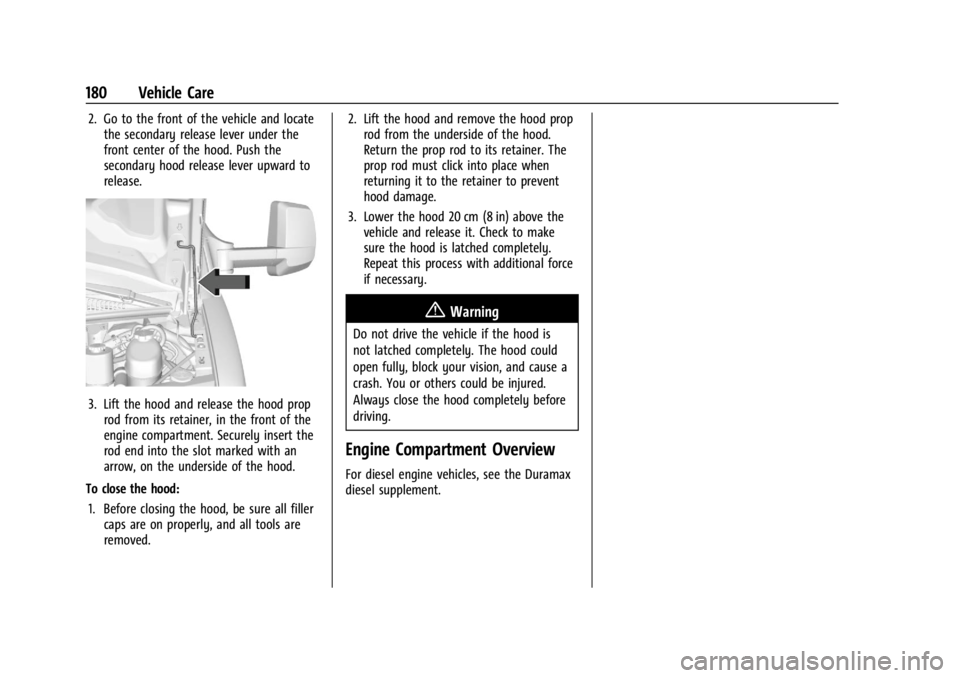
GMC Savana Owner Manual (GMNA-Localizing-U.S./Canada-14583543) -
2021 - crc - 7/10/20
180 Vehicle Care
2. Go to the front of the vehicle and locatethe secondary release lever under the
front center of the hood. Push the
secondary hood release lever upward to
release.
3. Lift the hood and release the hood proprod from its retainer, in the front of the
engine compartment. Securely insert the
rod end into the slot marked with an
arrow, on the underside of the hood.
To close the hood: 1. Before closing the hood, be sure all filler caps are on properly, and all tools are
removed. 2. Lift the hood and remove the hood prop
rod from the underside of the hood.
Return the prop rod to its retainer. The
prop rod must click into place when
returning it to the retainer to prevent
hood damage.
3. Lower the hood 20 cm (8 in) above the vehicle and release it. Check to make
sure the hood is latched completely.
Repeat this process with additional force
if necessary.
{Warning
Do not drive the vehicle if the hood is
not latched completely. The hood could
open fully, block your vision, and cause a
crash. You or others could be injured.
Always close the hood completely before
driving.
Engine Compartment Overview
For diesel engine vehicles, see the Duramax
diesel supplement.
Page 182 of 292
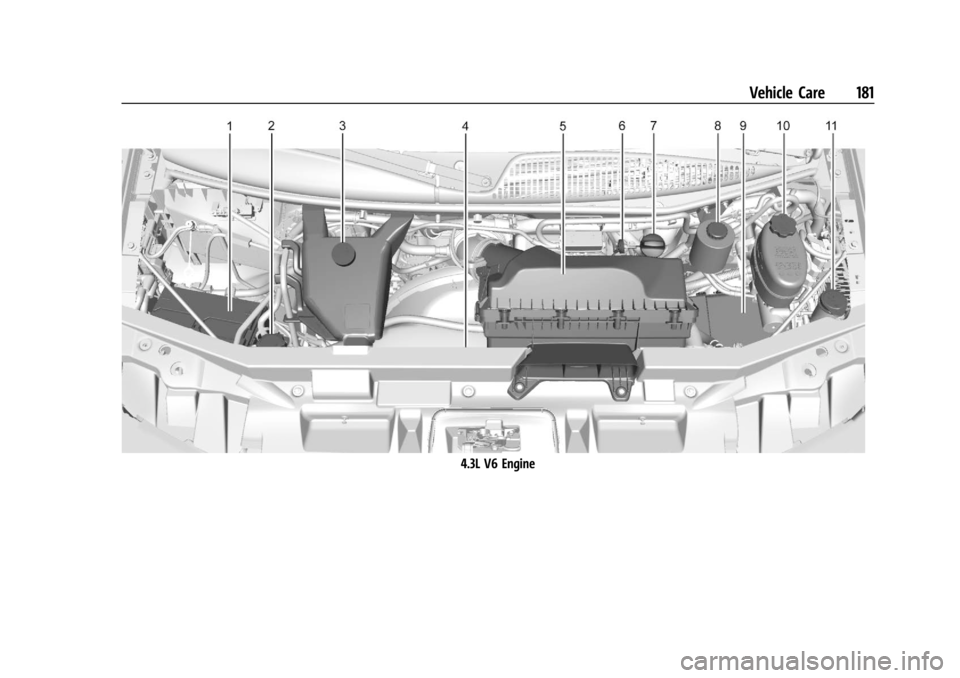
GMC Savana Owner Manual (GMNA-Localizing-U.S./Canada-14583543) -
2021 - crc - 7/10/20
Vehicle Care 181
4.3L V6 Engine
Page 183 of 292

GMC Savana Owner Manual (GMNA-Localizing-U.S./Canada-14583543) -
2021 - crc - 7/10/20
182 Vehicle Care
1.Battery - North America 0198.
2. Radiator Pressure Cap. See Cooling
System 0191.
3. Coolant Recovery Tank. See Cooling
System 0191.
4. Engine Oil Dipstick. See “Checking Engine
Oil” under Engine Oil 0184. 5. Engine Cooling Fan (Out of View). See
Cooling System 0191.
6. Engine Air Cleaner/Filter 0189.
7. Engine Oil Fill Cap. See “When to Add
Engine Oil” underEngine Oil 0184.
8. Power Steering Fluid Reservoir. See Power Steering Fluid 0196.
9. Engine Compartment Fuse Block 0206. 10. Brake Master Cylinder Reservoir. See
Brake Fluid 0197.
11. Windshield Washer Fluid Reservoir. See “Adding Washer Fluid” underWasher
Fluid 0196.
Page 184 of 292
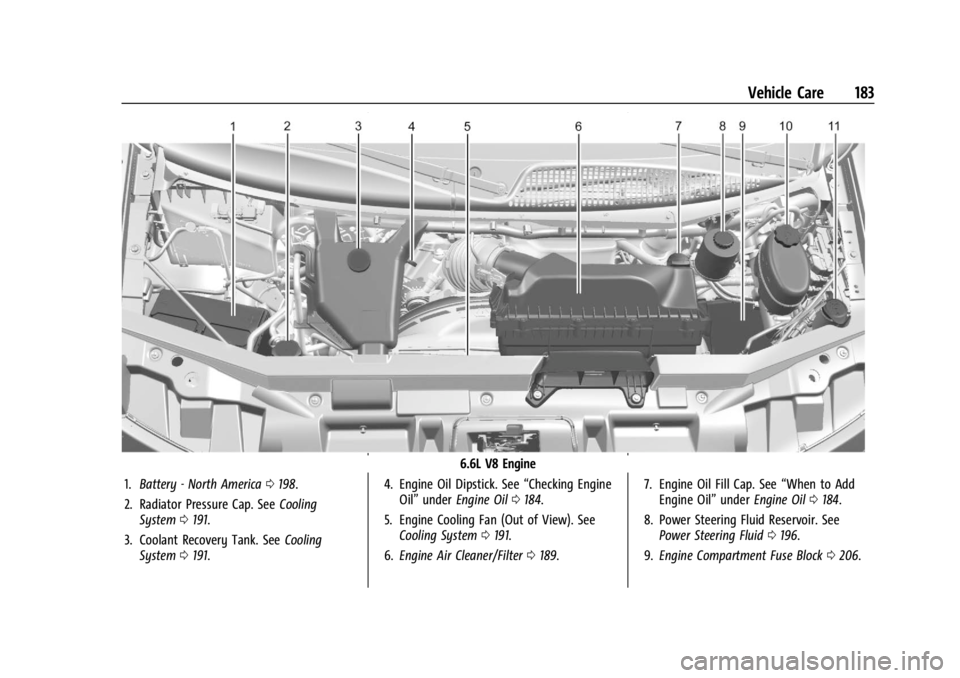
GMC Savana Owner Manual (GMNA-Localizing-U.S./Canada-14583543) -
2021 - crc - 7/10/20
Vehicle Care 183
6.6L V8 Engine
1. Battery - North America 0198.
2. Radiator Pressure Cap. See Cooling
System 0191.
3. Coolant Recovery Tank. See Cooling
System 0191. 4. Engine Oil Dipstick. See
“Checking Engine
Oil” under Engine Oil 0184.
5. Engine Cooling Fan (Out of View). See Cooling System 0191.
6. Engine Air Cleaner/Filter 0189. 7. Engine Oil Fill Cap. See
“When to Add
Engine Oil” underEngine Oil 0184.
8. Power Steering Fluid Reservoir. See Power Steering Fluid 0196.
9. Engine Compartment Fuse Block 0206.
Page 185 of 292
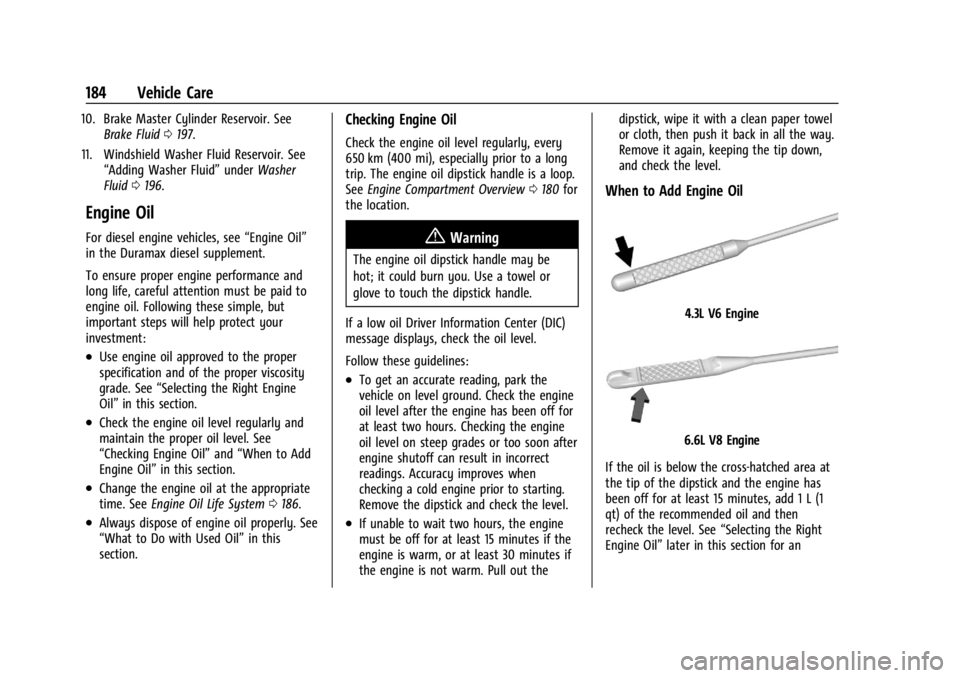
GMC Savana Owner Manual (GMNA-Localizing-U.S./Canada-14583543) -
2021 - crc - 7/10/20
184 Vehicle Care
10. Brake Master Cylinder Reservoir. SeeBrake Fluid 0197.
11. Windshield Washer Fluid Reservoir. See “Adding Washer Fluid” underWasher
Fluid 0196.
Engine Oil
For diesel engine vehicles, see “Engine Oil”
in the Duramax diesel supplement.
To ensure proper engine performance and
long life, careful attention must be paid to
engine oil. Following these simple, but
important steps will help protect your
investment:
.Use engine oil approved to the proper
specification and of the proper viscosity
grade. See “Selecting the Right Engine
Oil” in this section.
.Check the engine oil level regularly and
maintain the proper oil level. See
“Checking Engine Oil” and“When to Add
Engine Oil” in this section.
.Change the engine oil at the appropriate
time. SeeEngine Oil Life System 0186.
.Always dispose of engine oil properly. See
“What to Do with Used Oil” in this
section.
Checking Engine Oil
Check the engine oil level regularly, every
650 km (400 mi), especially prior to a long
trip. The engine oil dipstick handle is a loop.
See Engine Compartment Overview 0180 for
the location.
{Warning
The engine oil dipstick handle may be
hot; it could burn you. Use a towel or
glove to touch the dipstick handle.
If a low oil Driver Information Center (DIC)
message displays, check the oil level.
Follow these guidelines:
.To get an accurate reading, park the
vehicle on level ground. Check the engine
oil level after the engine has been off for
at least two hours. Checking the engine
oil level on steep grades or too soon after
engine shutoff can result in incorrect
readings. Accuracy improves when
checking a cold engine prior to starting.
Remove the dipstick and check the level.
.If unable to wait two hours, the engine
must be off for at least 15 minutes if the
engine is warm, or at least 30 minutes if
the engine is not warm. Pull out the dipstick, wipe it with a clean paper towel
or cloth, then push it back in all the way.
Remove it again, keeping the tip down,
and check the level.
When to Add Engine Oil
4.3L V6 Engine
6.6L V8 Engine
If the oil is below the cross-hatched area at
the tip of the dipstick and the engine has
been off for at least 15 minutes, add 1 L (1
qt) of the recommended oil and then
recheck the level. See “Selecting the Right
Engine Oil” later in this section for an
Page 186 of 292
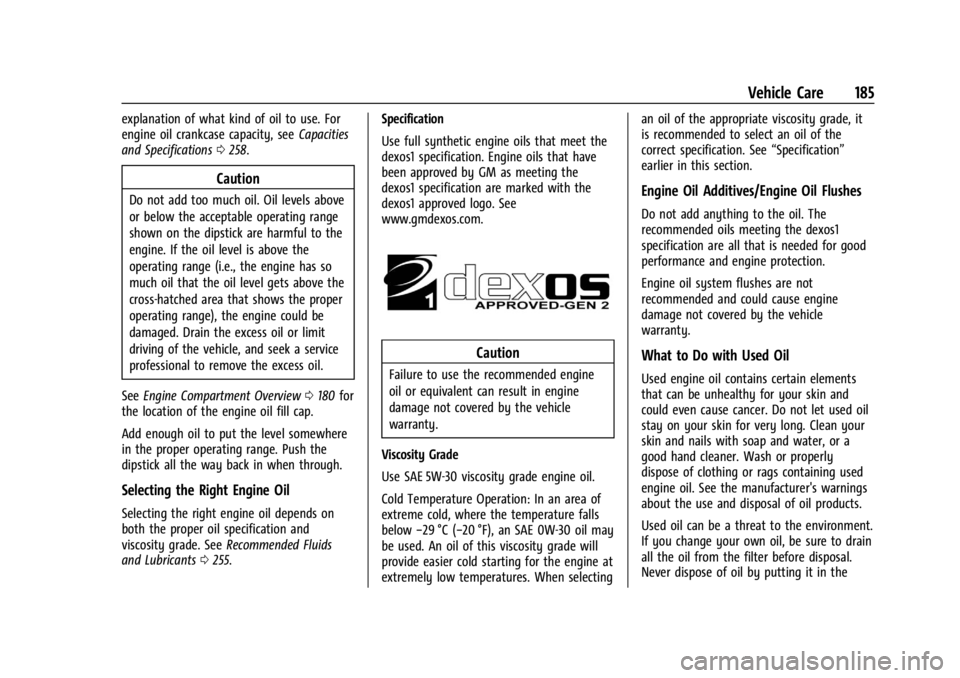
GMC Savana Owner Manual (GMNA-Localizing-U.S./Canada-14583543) -
2021 - crc - 7/10/20
Vehicle Care 185
explanation of what kind of oil to use. For
engine oil crankcase capacity, seeCapacities
and Specifications 0258.
Caution
Do not add too much oil. Oil levels above
or below the acceptable operating range
shown on the dipstick are harmful to the
engine. If the oil level is above the
operating range (i.e., the engine has so
much oil that the oil level gets above the
cross-hatched area that shows the proper
operating range), the engine could be
damaged. Drain the excess oil or limit
driving of the vehicle, and seek a service
professional to remove the excess oil.
See Engine Compartment Overview 0180 for
the location of the engine oil fill cap.
Add enough oil to put the level somewhere
in the proper operating range. Push the
dipstick all the way back in when through.
Selecting the Right Engine Oil
Selecting the right engine oil depends on
both the proper oil specification and
viscosity grade. See Recommended Fluids
and Lubricants 0255. Specification
Use full synthetic engine oils that meet the
dexos1 specification. Engine oils that have
been approved by GM as meeting the
dexos1 specification are marked with the
dexos1 approved logo. See
www.gmdexos.com.
Caution
Failure to use the recommended engine
oil or equivalent can result in engine
damage not covered by the vehicle
warranty.
Viscosity Grade
Use SAE 5W-30 viscosity grade engine oil.
Cold Temperature Operation: In an area of
extreme cold, where the temperature falls
below −29 °C (−20 °F), an SAE 0W-30 oil may
be used. An oil of this viscosity grade will
provide easier cold starting for the engine at
extremely low temperatures. When selecting an oil of the appropriate viscosity grade, it
is recommended to select an oil of the
correct specification. See
“Specification”
earlier in this section.
Engine Oil Additives/Engine Oil Flushes
Do not add anything to the oil. The
recommended oils meeting the dexos1
specification are all that is needed for good
performance and engine protection.
Engine oil system flushes are not
recommended and could cause engine
damage not covered by the vehicle
warranty.
What to Do with Used Oil
Used engine oil contains certain elements
that can be unhealthy for your skin and
could even cause cancer. Do not let used oil
stay on your skin for very long. Clean your
skin and nails with soap and water, or a
good hand cleaner. Wash or properly
dispose of clothing or rags containing used
engine oil. See the manufacturer's warnings
about the use and disposal of oil products.
Used oil can be a threat to the environment.
If you change your own oil, be sure to drain
all the oil from the filter before disposal.
Never dispose of oil by putting it in the
Page 187 of 292
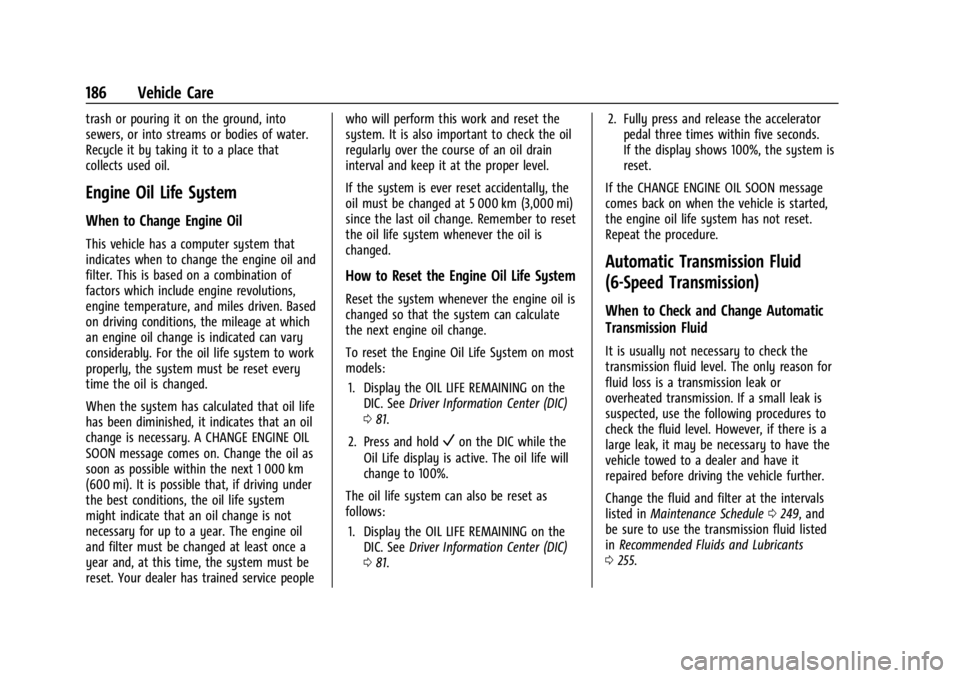
GMC Savana Owner Manual (GMNA-Localizing-U.S./Canada-14583543) -
2021 - crc - 7/10/20
186 Vehicle Care
trash or pouring it on the ground, into
sewers, or into streams or bodies of water.
Recycle it by taking it to a place that
collects used oil.
Engine Oil Life System
When to Change Engine Oil
This vehicle has a computer system that
indicates when to change the engine oil and
filter. This is based on a combination of
factors which include engine revolutions,
engine temperature, and miles driven. Based
on driving conditions, the mileage at which
an engine oil change is indicated can vary
considerably. For the oil life system to work
properly, the system must be reset every
time the oil is changed.
When the system has calculated that oil life
has been diminished, it indicates that an oil
change is necessary. A CHANGE ENGINE OIL
SOON message comes on. Change the oil as
soon as possible within the next 1 000 km
(600 mi). It is possible that, if driving under
the best conditions, the oil life system
might indicate that an oil change is not
necessary for up to a year. The engine oil
and filter must be changed at least once a
year and, at this time, the system must be
reset. Your dealer has trained service peoplewho will perform this work and reset the
system. It is also important to check the oil
regularly over the course of an oil drain
interval and keep it at the proper level.
If the system is ever reset accidentally, the
oil must be changed at 5 000 km (3,000 mi)
since the last oil change. Remember to reset
the oil life system whenever the oil is
changed.
How to Reset the Engine Oil Life System
Reset the system whenever the engine oil is
changed so that the system can calculate
the next engine oil change.
To reset the Engine Oil Life System on most
models:
1. Display the OIL LIFE REMAINING on the DIC. See Driver Information Center (DIC)
0 81.
2. Press and hold
Von the DIC while the
Oil Life display is active. The oil life will
change to 100%.
The oil life system can also be reset as
follows: 1. Display the OIL LIFE REMAINING on the DIC. See Driver Information Center (DIC)
0 81. 2. Fully press and release the accelerator
pedal three times within five seconds.
If the display shows 100%, the system is
reset.
If the CHANGE ENGINE OIL SOON message
comes back on when the vehicle is started,
the engine oil life system has not reset.
Repeat the procedure.
Automatic Transmission Fluid
(6-Speed Transmission)
When to Check and Change Automatic
Transmission Fluid
It is usually not necessary to check the
transmission fluid level. The only reason for
fluid loss is a transmission leak or
overheated transmission. If a small leak is
suspected, use the following procedures to
check the fluid level. However, if there is a
large leak, it may be necessary to have the
vehicle towed to a dealer and have it
repaired before driving the vehicle further.
Change the fluid and filter at the intervals
listed in Maintenance Schedule 0249, and
be sure to use the transmission fluid listed
in Recommended Fluids and Lubricants
0 255.
Page 188 of 292
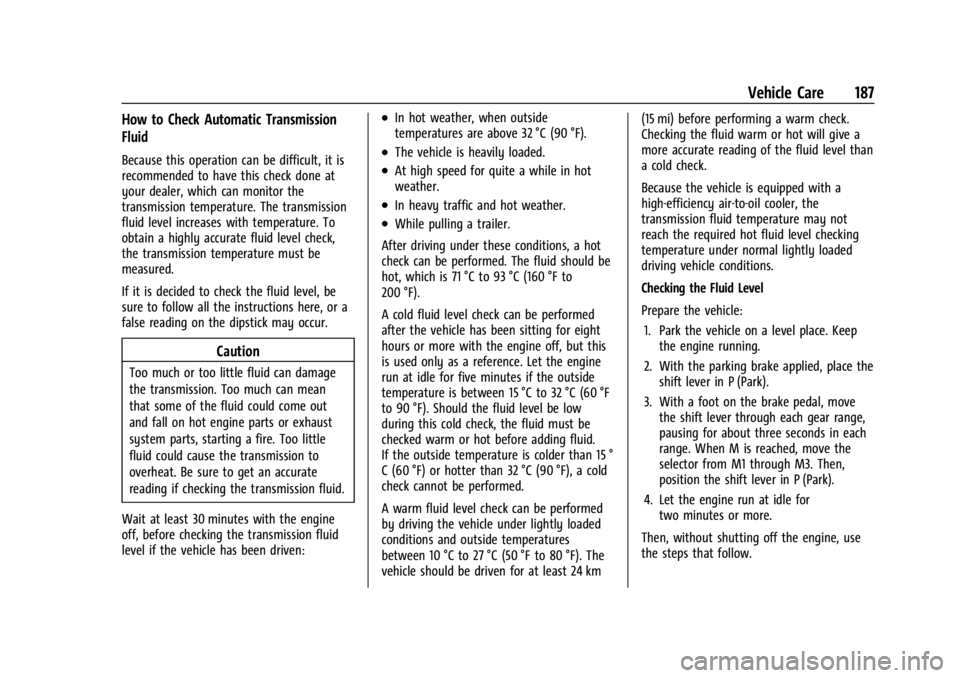
GMC Savana Owner Manual (GMNA-Localizing-U.S./Canada-14583543) -
2021 - crc - 7/10/20
Vehicle Care 187
How to Check Automatic Transmission
Fluid
Because this operation can be difficult, it is
recommended to have this check done at
your dealer, which can monitor the
transmission temperature. The transmission
fluid level increases with temperature. To
obtain a highly accurate fluid level check,
the transmission temperature must be
measured.
If it is decided to check the fluid level, be
sure to follow all the instructions here, or a
false reading on the dipstick may occur.
Caution
Too much or too little fluid can damage
the transmission. Too much can mean
that some of the fluid could come out
and fall on hot engine parts or exhaust
system parts, starting a fire. Too little
fluid could cause the transmission to
overheat. Be sure to get an accurate
reading if checking the transmission fluid.
Wait at least 30 minutes with the engine
off, before checking the transmission fluid
level if the vehicle has been driven:
.In hot weather, when outside
temperatures are above 32 °C (90 °F).
.The vehicle is heavily loaded.
.At high speed for quite a while in hot
weather.
.In heavy traffic and hot weather.
.While pulling a trailer.
After driving under these conditions, a hot
check can be performed. The fluid should be
hot, which is 71 °C to 93 °C (160 °F to
200 °F).
A cold fluid level check can be performed
after the vehicle has been sitting for eight
hours or more with the engine off, but this
is used only as a reference. Let the engine
run at idle for five minutes if the outside
temperature is between 15 °C to 32 °C (60 °F
to 90 °F). Should the fluid level be low
during this cold check, the fluid must be
checked warm or hot before adding fluid.
If the outside temperature is colder than 15 °
C (60 °F) or hotter than 32 °C (90 °F), a cold
check cannot be performed.
A warm fluid level check can be performed
by driving the vehicle under lightly loaded
conditions and outside temperatures
between 10 °C to 27 °C (50 °F to 80 °F). The
vehicle should be driven for at least 24 km (15 mi) before performing a warm check.
Checking the fluid warm or hot will give a
more accurate reading of the fluid level than
a cold check.
Because the vehicle is equipped with a
high-efficiency air-to-oil cooler, the
transmission fluid temperature may not
reach the required hot fluid level checking
temperature under normal lightly loaded
driving vehicle conditions.
Checking the Fluid Level
Prepare the vehicle:
1. Park the vehicle on a level place. Keep the engine running.
2. With the parking brake applied, place the shift lever in P (Park).
3. With a foot on the brake pedal, move the shift lever through each gear range,
pausing for about three seconds in each
range. When M is reached, move the
selector from M1 through M3. Then,
position the shift lever in P (Park).
4. Let the engine run at idle for two minutes or more.
Then, without shutting off the engine, use
the steps that follow.
Page 189 of 292
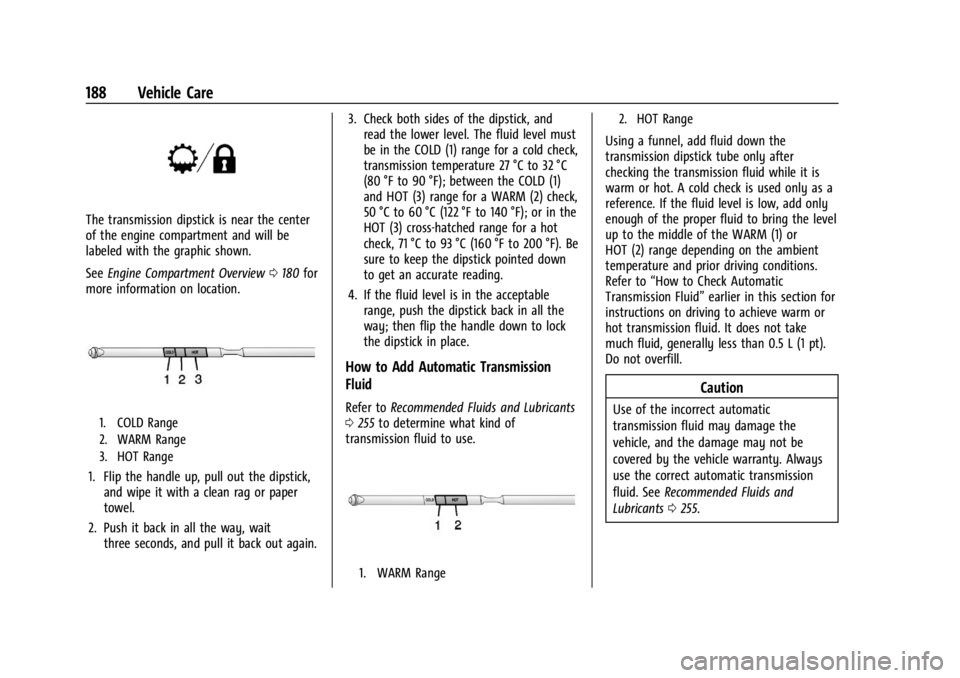
GMC Savana Owner Manual (GMNA-Localizing-U.S./Canada-14583543) -
2021 - crc - 7/10/20
188 Vehicle Care
The transmission dipstick is near the center
of the engine compartment and will be
labeled with the graphic shown.
SeeEngine Compartment Overview 0180 for
more information on location.
1. COLD Range
2. WARM Range
3. HOT Range
1. Flip the handle up, pull out the dipstick, and wipe it with a clean rag or paper
towel.
2. Push it back in all the way, wait three seconds, and pull it back out again. 3. Check both sides of the dipstick, and
read the lower level. The fluid level must
be in the COLD (1) range for a cold check,
transmission temperature 27 °C to 32 °C
(80 °F to 90 °F); between the COLD (1)
and HOT (3) range for a WARM (2) check,
50 °C to 60 °C (122 °F to 140 °F); or in the
HOT (3) cross-hatched range for a hot
check, 71 °C to 93 °C (160 °F to 200 °F). Be
sure to keep the dipstick pointed down
to get an accurate reading.
4. If the fluid level is in the acceptable range, push the dipstick back in all the
way; then flip the handle down to lock
the dipstick in place.
How to Add Automatic Transmission
Fluid
Refer to Recommended Fluids and Lubricants
0 255 to determine what kind of
transmission fluid to use.
1. WARM Range 2. HOT Range
Using a funnel, add fluid down the
transmission dipstick tube only after
checking the transmission fluid while it is
warm or hot. A cold check is used only as a
reference. If the fluid level is low, add only
enough of the proper fluid to bring the level
up to the middle of the WARM (1) or
HOT (2) range depending on the ambient
temperature and prior driving conditions.
Refer to
“How to Check Automatic
Transmission Fluid” earlier in this section for
instructions on driving to achieve warm or
hot transmission fluid. It does not take
much fluid, generally less than 0.5 L (1 pt).
Do not overfill.
Caution
Use of the incorrect automatic
transmission fluid may damage the
vehicle, and the damage may not be
covered by the vehicle warranty. Always
use the correct automatic transmission
fluid. See Recommended Fluids and
Lubricants 0255.
Page 190 of 292
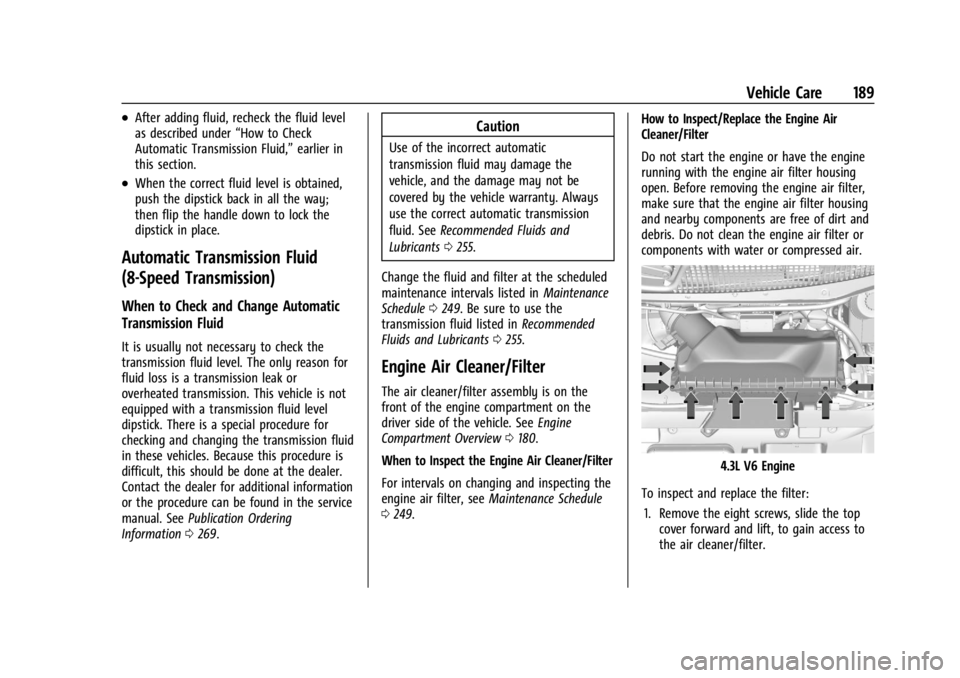
GMC Savana Owner Manual (GMNA-Localizing-U.S./Canada-14583543) -
2021 - crc - 7/10/20
Vehicle Care 189
.After adding fluid, recheck the fluid level
as described under“How to Check
Automatic Transmission Fluid,” earlier in
this section.
.When the correct fluid level is obtained,
push the dipstick back in all the way;
then flip the handle down to lock the
dipstick in place.
Automatic Transmission Fluid
(8-Speed Transmission)
When to Check and Change Automatic
Transmission Fluid
It is usually not necessary to check the
transmission fluid level. The only reason for
fluid loss is a transmission leak or
overheated transmission. This vehicle is not
equipped with a transmission fluid level
dipstick. There is a special procedure for
checking and changing the transmission fluid
in these vehicles. Because this procedure is
difficult, this should be done at the dealer.
Contact the dealer for additional information
or the procedure can be found in the service
manual. See Publication Ordering
Information 0269.
Caution
Use of the incorrect automatic
transmission fluid may damage the
vehicle, and the damage may not be
covered by the vehicle warranty. Always
use the correct automatic transmission
fluid. See Recommended Fluids and
Lubricants 0255.
Change the fluid and filter at the scheduled
maintenance intervals listed in Maintenance
Schedule 0249. Be sure to use the
transmission fluid listed in Recommended
Fluids and Lubricants 0255.
Engine Air Cleaner/Filter
The air cleaner/filter assembly is on the
front of the engine compartment on the
driver side of the vehicle. See Engine
Compartment Overview 0180.
When to Inspect the Engine Air Cleaner/Filter
For intervals on changing and inspecting the
engine air filter, see Maintenance Schedule
0 249. How to Inspect/Replace the Engine Air
Cleaner/Filter
Do not start the engine or have the engine
running with the engine air filter housing
open. Before removing the engine air filter,
make sure that the engine air filter housing
and nearby components are free of dirt and
debris. Do not clean the engine air filter or
components with water or compressed air.
4.3L V6 Engine
To inspect and replace the filter: 1. Remove the eight screws, slide the top cover forward and lift, to gain access to
the air cleaner/filter.